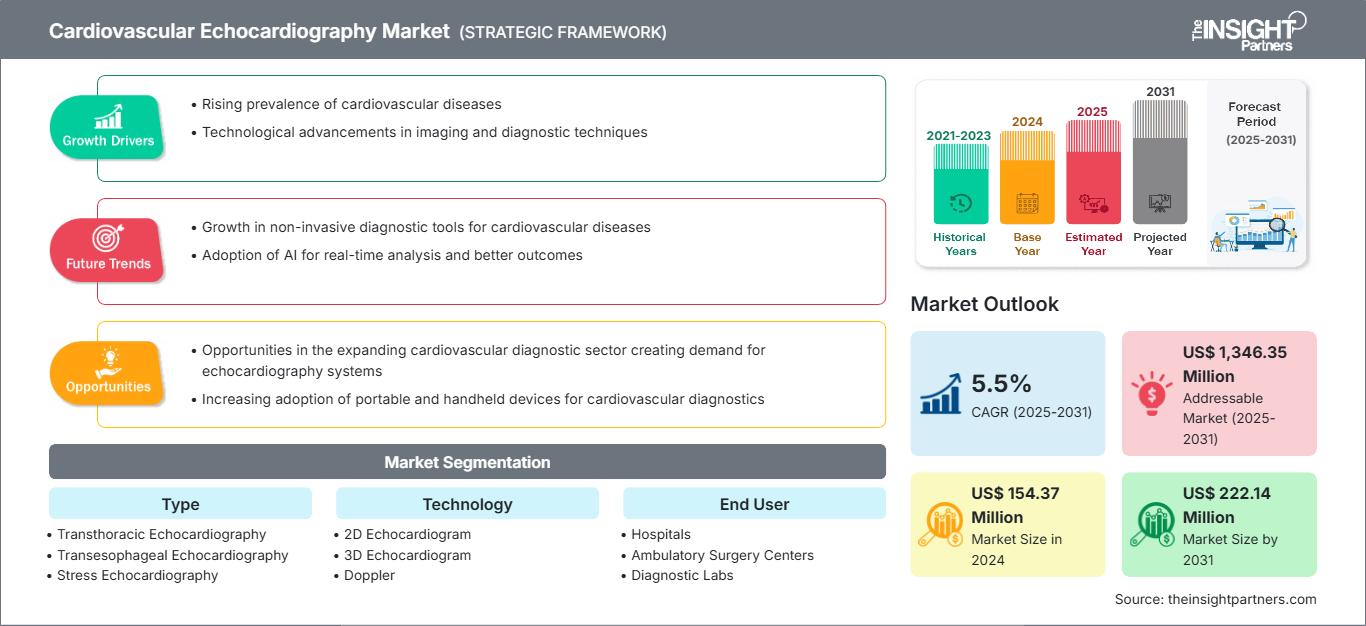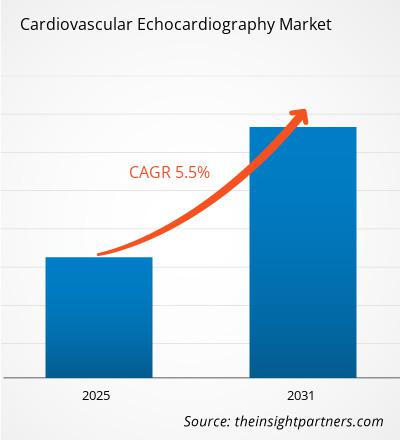[Rapporto di ricerca] Si prevede che il mercato dell'ecocardiografia cardiovascolare raggiungerà i 222,14 milioni di dollari entro il 2031, rispetto ai 154,37 milioni di dollari del 2024; si stima che il mercato registrerà un CAGR del 5,5% tra il 2025 e il 2031.
Approfondimenti di mercato e punto di vista degli analisti:
L'ecocardiografia cardiovascolare è un tipo di diagnostica per immagini che esamina il cuore. Utilizza onde sonore per creare immagini visive del cuore. Questa procedura di esame viene solitamente eseguita su pazienti con cardiopatie sospette o note. Oltre a rivelare le dimensioni e la forma delle camere e delle valvole, l'esame stima anche la funzionalità cardiaca calcolando la gittata cardiaca, la frazione di eiezione e la funzione diastolica. L'ecocardiografia cardiovascolare può anche rilevare cardiomiopatie. Le lesioni causate da un precedente infarto possono essere chiaramente visualizzate utilizzando gli ecocardiografi. L'ecografia cardiaca transtoracica, transesofagea e da sforzo sono tra i vari esami ecografici cardiaci eseguiti a scopo diagnostico. Si prevede che il crescente impatto delle malattie cardiovascolari e la crescente popolazione geriatrica creeranno ampie opportunità di crescita per il mercato dell'ecocardiografia cardiovascolare.
Fattori di crescita:
Durante l'esame e la valutazione di infarto, dolore toracico, coronaropatia, coaguli di sangue e altri disturbi cardiaci, i medici raccomandano trattamenti invasivi che prevedono esami del sangue e cateterizzazione cardiaca. La cateterizzazione cardiaca richiede una degenza ospedaliera prolungata e causa alcuni effetti collaterali come sanguinamento, coaguli di sangue, danni alle arterie e altre complicazioni. Per questi motivi, i medici in genere limitano l'uso di questa procedura per la diagnosi cardiaca e ricorrono invece al test da sforzo cardiaco nucleare, alla risonanza magnetica, all'ecografia cardiaca e all'angiografia coronarica con tomografia computerizzata, poiché queste procedure vengono eseguite in modo non invasivo.
L'ecocardiografia è l'esame diagnostico cardiovascolare più comunemente utilizzato dopo l'elettrocardiografia e la radiografia del torace. Si tratta di una procedura diagnostica non invasiva che fornisce informazioni sulla funzionalità cardiaca e sull'emodinamica. Grazie ai rischi minimi o nulli associati all'ecocardiografia rispetto ad altre procedure diagnostiche che utilizzano radiazioni per produrre risultati, si assiste a un'ampia adozione di questi dispositivi negli ospedali e nei centri diagnostici. Inoltre, i pazienti con una storia di insufficienza cardiaca traggono beneficio dal monitoraggio di routine con questi dispositivi diagnostici per le malattie cardiache. Contribuiscono inoltre a monitorare la malattia e l'efficacia del trattamento o dell'intervento chirurgico. Gli ecocardiogrammi sono utilizzati anche nell'assistenza infermieristica regolare dei pazienti sottoposti a trattamento oncologico a rischio di cardiotossicità.
I vantaggi associati all'utilizzo di dispositivi ecocardiografici rispetto ad altre procedure diagnostiche cardiache ne alimentano l'adozione, stimolando così la crescita del mercato dell'ecocardiografia cardiovascolare.
Le tendenze del mercato dell'ecocardiografia cardiovascolare includono l'integrazione dell'intelligenza artificiale e di altre tecnologie innovative nei dispositivi ecocardiografici.
Personalizza questo rapporto in base alle tue esigenze
Potrai personalizzare gratuitamente qualsiasi rapporto, comprese parti di questo rapporto, o analisi a livello di paese, pacchetto dati Excel, oltre a usufruire di grandi offerte e sconti per start-up e università
Mercato dell'ecocardiografia cardiovascolare: Approfondimenti strategici

-
Ottieni le principali tendenze chiave del mercato di questo rapporto.Questo campione GRATUITO includerà l'analisi dei dati, che vanno dalle tendenze di mercato alle stime e alle previsioni.
Segmentazione e ambito del rapporto:
L'analisi del mercato dell'ecocardiografia cardiovascolare è stata condotta considerando i seguenti segmenti: tipologia, tecnologia, utente finale e area geografica. In base alla tipologia, il mercato è segmentato in ecocardiografia transtoracica, ecocardiografia transesofagea, ecocardiografia da stress ed ecocardiografia fetale. In termini di tecnologia, il mercato è classificato in ecocardiografia 2D, ecocardiografia 3D e Doppler. In base all'utente finale, il mercato è suddiviso in ospedali, centri chirurgici ambulatoriali e laboratori diagnostici. L'ambito del rapporto sul mercato dell'ecocardiografia cardiovascolare copre Nord America (Stati Uniti, Canada e Messico), Europa (Francia, Germania, Regno Unito, Spagna, Italia e resto d'Europa), Asia-Pacifico (Cina, Giappone, India, Australia, Corea del Sud e resto dell'Asia-Pacifico), Medio Oriente e Africa. Africa (Arabia Saudita, Sudafrica, Emirati Arabi Uniti e resto del Medio Oriente e Africa) e America meridionale e centrale (Brasile, Argentina e resto dell'America meridionale e centrale).
Analisi segmentale:
Il mercato dell'ecocardiografia cardiovascolare, per tipologia, è suddiviso in ecocardiografia transtoracica, ecocardiografia da stress, ecocardiografia transesofagea ed ecocardiografia fetale. Il segmento dell'ecocardiografia transtoracica ha detenuto una quota di mercato significativa nel 2022. Si prevede che registrerà il CAGR più elevato del mercato tra il 2022 e il 2030.
In base alla tecnologia, il mercato è suddiviso in ecocardiogramma 2D, ecocardiogramma 3D e Doppler. Il segmento dell'ecocardiografia 3D ha detenuto una quota di mercato significativa nell'ecocardiografia cardiovascolare nel 2022 e si stima che registrerà il CAGR più elevato tra il 2022 e il 2030.
In base all'utente finale, il mercato è segmentato in ospedali, centri chirurgici ambulatoriali e laboratori diagnostici. Il segmento ospedaliero ha detenuto una quota di mercato significativa nell'ecocardiografia cardiovascolare nel 2022 e si prevede che registrerà il CAGR più elevato tra il 2022 e il 2030.
Approfondimenti regionali sul mercato dell'ecocardiografia cardiovascolare
Le tendenze regionali e i fattori che influenzano il mercato dell'ecocardiografia cardiovascolare durante il periodo di previsione sono stati ampiamente spiegati dagli analisti di The Insight Partners. Questa sezione illustra anche i segmenti e la geografia del mercato dell'ecocardiografia cardiovascolare in Nord America, Europa, Asia-Pacifico, Medio Oriente e Africa, America meridionale e centrale.
Ambito del rapporto di mercato sull'ecocardiografia cardiovascolare
| Attributo del rapporto | Dettagli |
|---|---|
| Dimensioni del mercato in 2024 | US$ 154.37 Million |
| Dimensioni del mercato per 2031 | US$ 222.14 Million |
| CAGR globale (2025 - 2031) | 5.5% |
| Dati storici | 2021-2023 |
| Periodo di previsione | 2025-2031 |
| Segmenti coperti |
By Tipo
|
| Regioni e paesi coperti |
Nord America
|
| Leader di mercato e profili aziendali chiave |
|
Densità degli operatori del mercato dell'ecocardiografia cardiovascolare: comprendere il suo impatto sulle dinamiche aziendali
Il mercato dell'ecocardiografia cardiovascolare è in rapida crescita, trainato dalla crescente domanda degli utenti finali, dovuta a fattori quali l'evoluzione delle preferenze dei consumatori, i progressi tecnologici e una maggiore consapevolezza dei benefici del prodotto. Con l'aumento della domanda, le aziende stanno ampliando la propria offerta, innovando per soddisfare le esigenze dei consumatori e sfruttando le tendenze emergenti, alimentando ulteriormente la crescita del mercato.

- Ottieni il Mercato dell'ecocardiografia cardiovascolare Panoramica dei principali attori chiave
Analisi regionale:
Geograficamente, il mercato dell'ecocardiografia cardiovascolare è segmentato in Nord America, Europa, Asia-Pacifico, America meridionale e centrale e Medio Oriente e Africa. Nel 2022, il Nord America ha conquistato una quota significativa del mercato. Nel 2022, gli Stati Uniti hanno dominato il mercato in questa regione. La crescita del mercato in Nord America è attribuita alla crescente incidenza delle malattie cardiache, all'aumento della popolazione geriatrica e alla presenza di importanti attori del mercato nella regione.
Le malattie cardiache sono una delle principali cause di morte negli Stati Uniti. Secondo i Centers for Disease Control and Prevention (CDC), circa 805.000 persone hanno un infarto negli Stati Uniti ogni anno. Inoltre, la coronaropatia è la forma più comune di cardiopatia, che ha causato la morte di 360.900 persone nel 2019. Secondo il CDC, si stima che 12,1 milioni di persone negli Stati Uniti soffriranno di fibrillazione atriale nel 2030. Analogamente, secondo il Canadian Chronic Disease Surveillance System, circa 1 adulto canadese su 12 (2,6 milioni) di età pari o superiore a 20 anni vive con una cardiopatia diagnosticata nel Paese. Secondo Statistics Canada, 67.399 persone sono decedute a causa di malattie cardiache o ictus nel 2020. Pertanto, il crescente numero di malattie cardiovascolari colpisce una popolazione considerevole. Ciò comporta una maggiore domanda di strumenti diagnostici, come l'ecocardiografia cardiovascolare, per valutare e monitorare la salute cardiovascolare, stimolando così il mercato dell'ecocardiografia cardiovascolare nella regione.
Panorama competitivo e aziende chiave:
Le previsioni di mercato dell'ecocardiografia cardiovascolare possono aiutare gli stakeholder a pianificare le proprie strategie di crescita. Apex Heart and Vascular, Ultra-X Imaging, Metropolitan Heart Vascular Institute, Ultromics Limited, Corewell Health, Centinela Hospital Medical Center, Schoolcraft Memorial Hospital, University of Utah Health, Goshen Heart & Vascular Center e Harefield Hospital sono tra i principali attori descritti nel rapporto di mercato dell'ecocardiografia cardiovascolare. Queste aziende si concentrano sull'introduzione di nuovi prodotti ad alta tecnologia, sul miglioramento dei prodotti esistenti e sull'espansione geografica per soddisfare la crescente domanda dei consumatori in tutto il mondo.
- Analisi storica (2 anni), anno base, previsione (7 anni) con CAGR
- Analisi PEST e SWOT
- Valore/volume delle dimensioni del mercato - Globale, Regionale, Nazionale
- Industria e panorama competitivo
- Set di dati Excel
Report recenti
Testimonianze
Motivo dell'acquisto
- Processo decisionale informato
- Comprensione delle dinamiche di mercato
- Analisi competitiva
- Analisi dei clienti
- Previsioni di mercato
- Mitigazione del rischio
- Pianificazione strategica
- Giustificazione degli investimenti
- Identificazione dei mercati emergenti
- Miglioramento delle strategie di marketing
- Aumento dell'efficienza operativa
- Allineamento alle tendenze normative






















 Ottieni un campione gratuito per - Mercato dell'ecocardiografia cardiovascolare
Ottieni un campione gratuito per - Mercato dell'ecocardiografia cardiovascolare